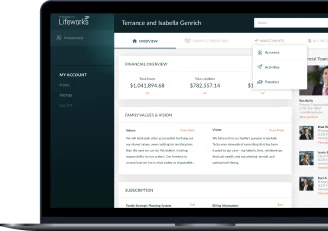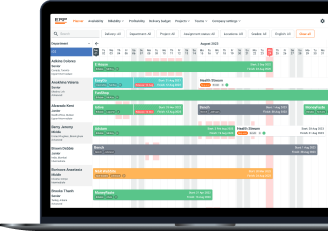Data migration services
-
Expand business services by building flexible, scalable, and high-performance data infrastructure
-
Ensure data security before, during, and after migration with industry-compliant security controls and regular testing
-
Decrease on-premises data infrastructure maintenance costs by transferring datasets into a cost-efficient cloud environment
-
Eliminate risks of losing or compromising data with compatibility checks and parallel testing
-
Modernize legacy software and facilitate digital transformation with a custom data migration strategy
What progressive businesses achieve after data migration
-
UP TO 100%
compliance with industry standards
-
UP TO 85%
increase in data accessibility
-
UP TO 5x
growth in data handling capacity post-migration
-
UP TO 80%
reduction in data errors post-migration
Data migration and integration services Yalantis provides
Prepare for a secure and incremental data migration process with a custom strategy based on your company’s needs. We continuously check data integrity and system performance during and after migration to guarantee business continuity.
-
Data migration planning and strategy development
-
Assessing data architecture
-
Defining a data migration scope
-
Determining risks
-
Setting up a data governance framework
-
Preparing a total cost of ownership (TCO) report
-
Allocating resources
-
-
Legacy system migration
-
Optimizing and modernizing legacy software
-
Prioritizing software features for migration
-
Reviewing and updating the codebase
-
Aligning data formats with the target environment
-
Setting up a data lifecycle management flow
-
-
Cloud data migration
-
Defining cloud deployment approach (public, private, hybrid, multi-cloud)
-
Choosing a cloud migration strategy (refactor, replatform, rehost)
-
Selecting suitable cloud and data migration service providers
-
-
Testing and validation
-
Parallel system testing during migration
-
Testing post-migration infrastructure
-
Validating data integrity and consistency
-
Performing data reconciliation
-
Monitoring system performance in the new environment
-
Resolving inefficiencies during and after migration
-
-
Cross-platform migration
-
Migrating from one cloud environment to another
-
Enabling cross-OS migration
-
Migrating to SaaS
-
Ensuring API compatibility
-
Maintaining consistent performance
-
-
Database optimization during migration
-
Analyzing database design
-
Evaluating performance metrics
-
Conducting compatibility checks
-
Choosing database sharing models (physical, logical)
-
-
Compliance and data security management
-
Ensuring compliance with regulatory requirements (GDPR, HIPAA, PCI DSS) during migration
-
Implementing security measures during data transit and storage
-
-
Post-migration support
-
Releasing patch updates
-
Performing ongoing system health checks
-
Maximizing database efficiency
-
Providing training sessions
-
Give new life to your siloed data
Migrate datasets into the cloud, upgraded database, or a new operating system, and increase the speed and quality of your service delivery.
Yalantis: A data migration services company with a proven portfolio
Data migration use cases by industry
-
Finance
-
Legacy system update to meet regulatory requirements
-
Mobile banking
-
AI/ML-driven financial analytics
-
Advanced fraud detection and prevention solutions
-
-
Healthcare
-
Migration of patient records and clinical data to new systems and platforms
-
Aggregation of medical images (DICOM, non-DICOM)
-
Integration with medical IoT devices
-
-
Manufacturing
-
Integration with industrial IoT devices and IoT-enabled systems
-
Aggregation of production and inventory data for secure retrieval and analysis
-
Streamlined production flow with advanced manufacturing systems
-
-
Supply chain
-
Predictive analytics with scalable cloud-based infrastructure
-
Integrated environment for all parties involved in supply chain management
-
Shipment tracking to avoid product damage
-
Improved route planning with increased computing power
-
Data Modernisation:
Unlock your business data’s potential with a modern, cost-effective system that makes data accessible, actionable, and easy for your team to embrace.
Insights into Yalantis’ data migration service

Cloud Migration Strategy Guide: Step-by-Step
In this extensive guide, we unveil the top reasons for cloud migration, touch upon security concerns, and discuss the process of cloud migration step-by-step.

How to migrate a traditional app to SaaS: Yalantis approach
Migrating to a SaaS business model is complex but possible. Go through a full and proven plan of action based on Yalantis’ experience.

How do we perform an architecture assessment process at Yalantis with TOGAF?
Explore the Yalantis architecture assessment process with software architecture assessment templates and examples.
FAQ
How long does data migration take?
Together with you, our business analysts, data engineers, and data migration consultants define and prioritize which software solutions or separate software features require migration. If, for instance, you need your entire IT infrastructure transferred from on-premises to the cloud then of course we’re talking of years. But to provide you with an accurate time estimate for a data migration service, we need to analyze your data architecture and data infrastructure condition and devise a custom data migration strategy
Analyzing and gathering requirements may take up to a month. But it helps us get a grasp of your data workflow, business processes, and define bottlenecks to fix before data migration. However, we don’t recommend getting too caught up in time frames. Data migration should be a cautious and incremental process without hurrying and with continuous system monitoring and testing. This way, you can maintain data safety and business continuity.
Do your data migration services include migration to cloud platforms like AWS, Azure, or Google Cloud?
We have experience working with all three cloud and data migration service providers. Yalantis data migration experts know how to negotiate pricing models for our clients and make cloud migration services more cost- and time-efficient.
But before choosing a provider, we recommend you decide on the cloud model: public, private, hybrid, multi-cloud, or hybrid multi-cloud. The last two are preferable if you want to avoid vendor lock-in and cooperate with several cloud providers. Depending on the cloud model, each provider has its pros and cons. For instance, some cloud vendors have location limitations. And if you plan on expanding your business to countries that aren’t covered by a certain cloud provider, you should consider choosing a different one.
All these nuances we communicate individually with each of our clients to help them make the most suitable and cost-efficient choice for their business.
How do you as a data migration company ensure data security during migration?
Our data migration experts help you secure your data infrastructure before migration. We prioritize datasets based on sensitivity, communicate all the risks with you, and strictly follow industry regulatory requirements. Yalantis SecOps experts perform:
- automated security control checks
- parallel system testing
- vulnerability scanning
- security audits during and post-migration
Suppose you’re migrating data from on-premises legacy systems to the cloud or from one cloud environment to another. In that case, we help you choose the most secure cloud model that will not be a rip-off and will not compromise your company data.
As a measure of precaution, we can also conduct a pilot migration before a large-scale one to test the process and minimize risks for the business. We choose datasets that aren’t critical for the business, migrate them to the cloud or a different system, and then measure the results.
What kind of post-migration support does Yalantis provide?
We help businesses maintain stable and secure performance after data and database migration services. Our SecOps specialists, data migration consultants, and data engineering teams are available for on-demand consultations to:
- conduct security audits
- integrate additional data tools and technologies to support your data infrastructure
- monitor system health and fix issues if such occur
We can also gather user feedback to timely act on it and suggest improvements. You can rely on our expertise before, during, and after data migration services.
Key steps of the data migration process: Caution, precision, and security are three pillars of trusted data migration service providers
Successful data migration and integration are possible only with due preparation and experienced data migration experts and consultants. Below are critical steps to make this process smooth and with minimal downtime.
Step #1. Prioritizing needs
Lifting and shifting an entire IT infrastructure of your enterprise might be a risky endeavor. You should consider starting with data migration services for a few departments, validate the results, and assess how data migration affects data analytics for these departments and what outcomes your business can gain. Once you’ve tested the waters and know all the dos and don’ts for your business in terms of data migration—you can proceed to a more large-scale data migration.
Step #2. Data migration roadmap
At this stage, define:
- sources and destinations for data migration services
- how your systems currently operate
- data architecture and database condition
- codebase relevancy and tech stack
- data migration scope
- cloud model (if you’re transitioning to the cloud)
Based on the above information, we’ll be able to compose a time and budget estimate for data migration services and effectively allocate tasks and resources. Based on a detailed data migration roadmap and scope, Yalantis data engineers can design a custom data migration strategy that can cover not only your current needs but also future plans to ensure iterative digital transformation.
Step #3. Data migration model
Decide on the suitable data or database migration model:
- Partial data migration is best for businesses that need their company to operate 24/7 and won’t tolerate even minimal downtime. Partial data migration services can take longer than full data migration.
- Full data migration can be quicker than partial migration but your business services won’t be available to users for a certain period. The duration of full data integration and migration services depends on the volume of data that needs to be migrated.
- Data mirroring undermines data replication from one system to another without disruption to the original system or loss in data quality and consistency.
Step #4. Data mapping and unification
For consistent and efficient data migrations, data engineers should bridge the difference between the source and destination (e.g. align data formats). Our specialists can automate this process to avoid errors when mapping large volumes of data. After effective data mapping, source fields will match destination fields, and data migration won’t be a disruption for your business. Data unification is also critical if you need to migrate data from several disparate sources such as manual Excel spreadsheets and paper documentation.
Step #5. Architecture and database redesign
The architecture trade-off analysis method (ATAM), the open group architecture framework (TOGAF), or the perspective-based analysis method (PBAM) help solution architects thoroughly evaluate the architecture of your source system before data migrations.
Assessment may indicate how to improve or redesign your current architecture for a seamless data and database migration process. For instance, it might be necessary to transition from a monolithic architecture to microservices to achieve higher flexibility and improve disaster recovery.
Step #6. Pilot migration
Conduct low-key data migrations with non-critical (or fictional) datasets to make sure the process runs as intended and there are no unexpected issues. And if issues occur, you can fix them before an actual migration with minimum risks. Plus, pilot migration gives you practical experience to share with your stakeholders and get buy-in for your full-scale data migration strategy. Yalantis is an experienced data migration services company and we know how to perform data migration of different scales.
Step #7. Data migration with ongoing testing and validation
After the initial data migration ride and armed with first-hand knowledge, we can perform a large-scale data migration. To guarantee secure data migration, the Yalantis team continuously validates data quality, consistency, and integrity. Compliance with industry regulations is also essential to ensure a loss-free data migration process.
Data migration automation: What tools and technologies Yalantis uses to speed up the migration
Our data engineers implement diverse data migration tools and technologies (data integration tools, data migration platforms with ETL processes, and data connectors) to automate and expedite this process. To select a suitable tool, they analyze them based on four criteria:
- Flexibility. Flexible tools allow data engineers to timely fix unexpected issues during migration.
- Reliability. Data migration must run without interruption or delays.
- Security. To avoid data leaks or compromising, our experts choose solutions that are compliant and secure.
- Pricing. A high quality-to-price ratio is essential, as we need cost-efficient tools and technologies that cover most project needs such as data science or data mining capabilities.
To automate data migration on even more budget-friendly and flexible terms, we can also use scripting languages such as Python to write custom scripts and integrate with an SQL server or any other databse. Scripts can extract files, transform them, and load them into target systems. Custom scripts can run on schedules and be triggered by certain events. They can be particularly helpful during partial data transfer as they gradually extract and load data into a target system while users still have access to the source system features.
Custom scripts may require more time to develop while ready-made data migration tools allow for quick project setup. Using the best of both worlds is a possibility to achieve high customization along with speed and automation. Plus, we have an in-house pool of automation tools such as our DevOps accelerator. It enables quick infrastructure setup with reusable components that may require only minor fine-tuning to fit different business and industry requirements. With its help, we can ensure up to four times faster infrastructure deployment and data transfer.
Combining our high technical expertise, industry knowledge, trusted cloud services, and internal and external automation tools, we can build a data migration process that is quick and highly efficient for your unique business processes. To preserve business continuity and enable smooth data migration, we guarantee our full involvement in the process and on-call availability in case any issues occur that may disrupt your workflow.
With Yalantis, you can turn data challenges into business opportunities. Ensure data migration success and adopt advanced data analytics technologies that drive intelligent decisions and help you stay ahead of the curve in the industry.
Drive digital transformation initiatives with a custom data migration strategy

got it!
Keep an eye on your inbox. We’ll be in touch shortlyrnMeanwhile, you can explore our hottest case studies and readrnclient feedback on Clutch.
See Yalantis reviews
Lisa Panchenko
Senior Engagement Manager
Your steps with Yalantis
-
Schedule a call
-
We collect your requirements
-
We offer a solution
-
We succeed together!




